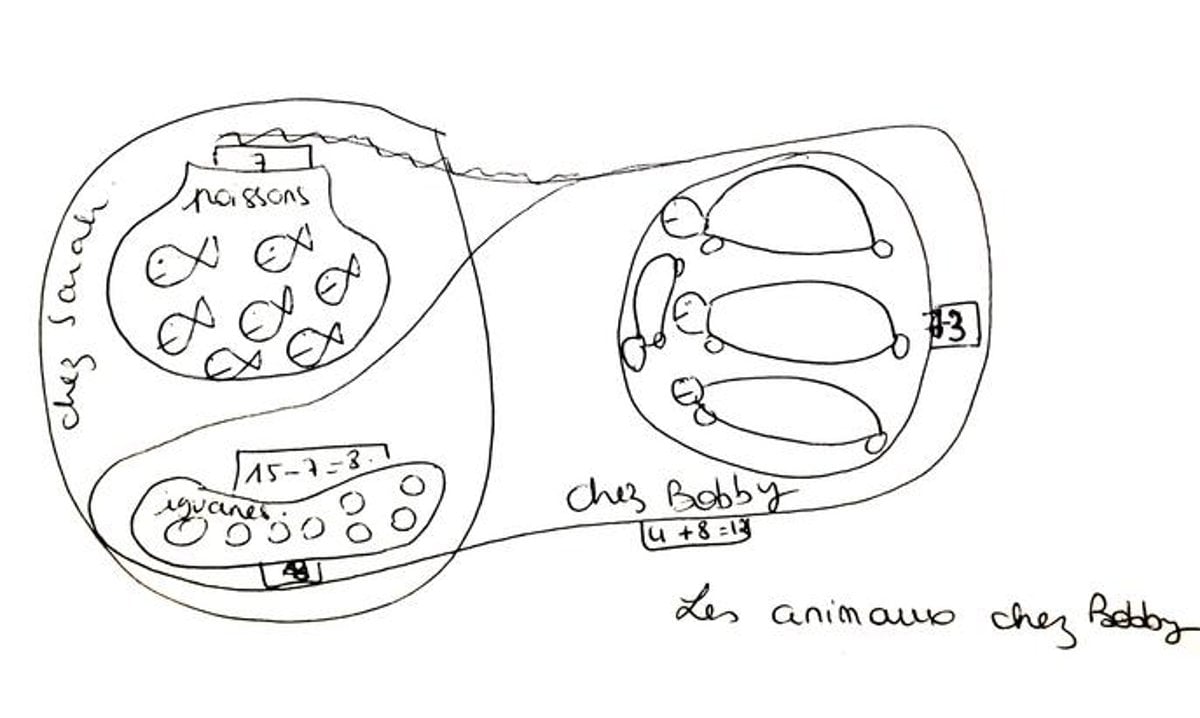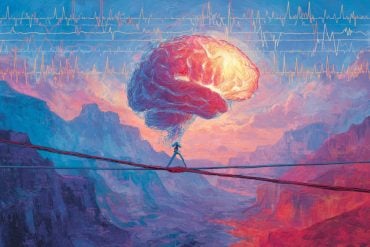Summary: Researchers uncovered the connection between individuals’ drawings and their arithmetic problem-solving strategies. By analyzing the illustrations produced by both children and adults when tasked with solving simple mathematical problems, the research team discovered that certain types of drawings correlate with the most efficient calculation methods.
This finding suggests that visual representations can significantly impact one’s ability to devise and apply optimal solutions to arithmetic challenges. The study not only highlights the enduring difference between cardinal and ordinal problem-solving approaches but also proposes drawing analysis as a novel method to enhance mathematical learning and instruction.
Key Facts:
- Impact of Visual Representations: The study revealed that the nature of drawings, whether cardinal or ordinal, influences the selection of calculation strategies, with ordinal representations often leading to more direct solutions.
- Age-Independent Findings: Similar results were observed among both adults and children, indicating that the influence of visual representations on problem-solving transcends age and experience.
- Pedagogical Implications: The research suggests that analyzing students’ drawings could provide educators with insights into their understanding and representation of mathematical problems, offering a new avenue for optimizing teaching strategies.
Source: University of Geneva
Solving arithmetic problems, even simple subtractions, involves mental representations whose influence remains to be clarified. Visualizing these representations would enable us to better understand our reasoning and adapt our teaching methods.
A team from the University of Geneva (UNIGE), in collaboration with CY Cergy Paris University (CYU) and University of Burgundy (uB), analyzed drawings made by children and adults when solving simple problems. The scientists found that, whatever the age of the participant, the most effective calculation strategies were associated with certain drawing typologies.

These results, published in the journal Memory & Cognition, open up new perspectives for the teaching of mathematics.
Learning mathematics often involves small problems, linked to concrete everyday situations. For example, pupils have to add up quantities of flour to make a recipe or subtract sums of money to find out what’s left in their wallets after shopping. They are thus led to translate statements into algorithmic procedures to find the solution.
This translation of words into solving strategies involves a stage of mental representation of mathematical information, such as numbers or the arithmetic operation to be performed, and non-mathematical information, such as the context of the problem.
The cardinal or ordinal dimensions of problems
Having a clearer idea of these mental representations would enable a better understanding of the choice of calculation strategies. Scientists from UNIGE, CYU and uB conducted a study with 10-year-old children and adults, asking them to solve simple problems with the instruction to use as few calculation steps as possible.
The participants were then asked to produce a drawing or diagram explaining their problem-solving strategy for each statement. The contexts of some problems called on the cardinal properties of numbers – the quantity of elements in a set – others on their ordinal properties – their position in an ordered list.
The former involved marbles, fishes, or books, for example: ‘‘Paul has 8 red marbles. He also has blue marbles. In total, Paul has 11 marbles. Jolene has as many blue marbles as Paul, and some green marbles. She has 2 green marbles less than Paul has red marbles. In total, how many marbles does Jolene have?’’.
The latter involved lengths or durations, for example: ‘‘Sofia traveled for 8 hours. Her trip started during the day. Sofia arrived at 11. Fred leaves at the same time as Sofia. Fred’s trip lasted 2 hours less than Sofia’s. What time was it when Fred arrived?”
Both of the above problems share the same mathematical structure, and both can be solved by a long strategy in 3 steps: 11 – 8 = 3; 8 – 2 = 6; 6 + 3 = 9, but also in a single calculation: 11 – 2 = 9, using a simple subtraction.
However, the mental representations of these problems are very different, and the researchers wanted to determine whether the type of representations could predict the calculation strategy, in 1 or 3 steps, of those who solve them.
“Our hypothesis was that cardinal problems – such as the one involving marbles – would inspire cardinal drawings, i.e. diagrams with identical individual elements, such as crosses or circles, or with overlaps of elements in sets or subsets.
Similarly, we assumed that ordinal problems – such as the one mentioning travel times – would lead to ordinal representations, i.e. diagrams with axes, graduations or intervals – and that these ordinal drawings would reflect participants’ representations and indicate that they would be more successful in identifying the one-step solution strategy,’’ explains Hippolyte Gros, former post-doctoral fellow at UNIGE’s Faculty of Psychology and Educational Sciences, associate professor at CYU, and first author of the study.
Identifying mental representations through drawings
These hypotheses were validated by analyzing the drawings of 52 adults and 59 children.
‘‘We have shown that, irrespective of their experience – since the same results were obtained in both children and adults – the use of strategies by the participants depends on their representation of the problem, and that this is influenced by the non-mathematical information contained in the problem statement, as revealed by their drawings,’’ says Emmanuel Sander, full professor at the UNIGE’s Faculty of Psychology and Educational Sciences.
‘‘Our study also shows that, even after years of experience in solving addition and subtraction, the difference between cardinal and ordinal problems remains very marked. The majority of participants were only able to solve problems of the second type in a single step’’.
Improving mathematical learning through drawing analysis
The team also noted that drawings showing ordinal representations were more frequently associated with a one-step solution, even if the problem was cardinal. In other words, drawing with a scale or an axis is linked to the choice of the fastest calculation.
“From a pedagogical point of view, this suggests that the presence of specific features in a student’s drawing may or may not indicate that his or her representation of the problem is the most efficient one for meeting the instructions – in this case, solving with the fewest calculations possible,” observes Jean-Pierre Thibaut, full professor at the uB Laboratory for Research on Learning and Development.
‘‘Thus, when it comes to subtracting individual elements, a representation via an axis – rather than via subsets – is more effective in finding the fastest method. Analysis of students’ drawings in arithmetic can therefore enable targeted intervention to help them translate problems into more optimal representations.
“One way of doing this is to work on the graphical representation of statements in class, to help students understand the most direct strategies,’’ concludes Hippolyte Gros.
About this math, art, and problem-solving research news
Author: Antoine Guenot
Source: University of Geneva
Contact: Antoine Guenot – University of Geneva
Image: The image is credited to Hippolyte Gros
Original Research: Closed access.
“Uncovering the interplay between drawings, mental representations, and arithmetic problem-solving strategies in children and adults” by Hippolyte Gros et al. Memory and Cognition
Abstract
Uncovering the interplay between drawings, mental representations, and arithmetic problem-solving strategies in children and adults
There is an ongoing debate in the scientific community regarding the nature and role of the mental representations involved in solving arithmetic word problems.
In this study, we took a closer look at the interplay between mental representations, drawing production, and strategy choice. We used dual-strategy isomorphic word problems sharing the same mathematical structure, but differing in the entities they mentioned in their problem statement.
Due to the non-mathematical knowledge attached to these entities, some problems were believed to lead to a specific (cardinal) encoding compatible with one solving strategy, whereas other problems were thought to foster a different (ordinal) encoding compatible with the other solving strategy.
We asked 59 children and 52 adults to solve 12 of those arithmetic word problems and to make a diagram of each problem. We hypothesized that the diagrams of both groups would display prototypical features indicating either a cardinal representation or an ordinal representation, depending on the entities mentioned in the problem statement.
Joint analysis of the drawing task and the problem-solving task showed that the cardinal and ordinal features of the diagrams are linked with the hypothesized semantic properties of the problems and, crucially, with the choice of one solving strategy over another.
We showed that regardless of their experience, participants’ strategy use depends on their problem representation, which is influenced by the non-mathematical information in the problem statement, as revealed in their diagrams. We discuss the relevance of drawing tasks for investigating mental representations and fostering mathematical development in school.






